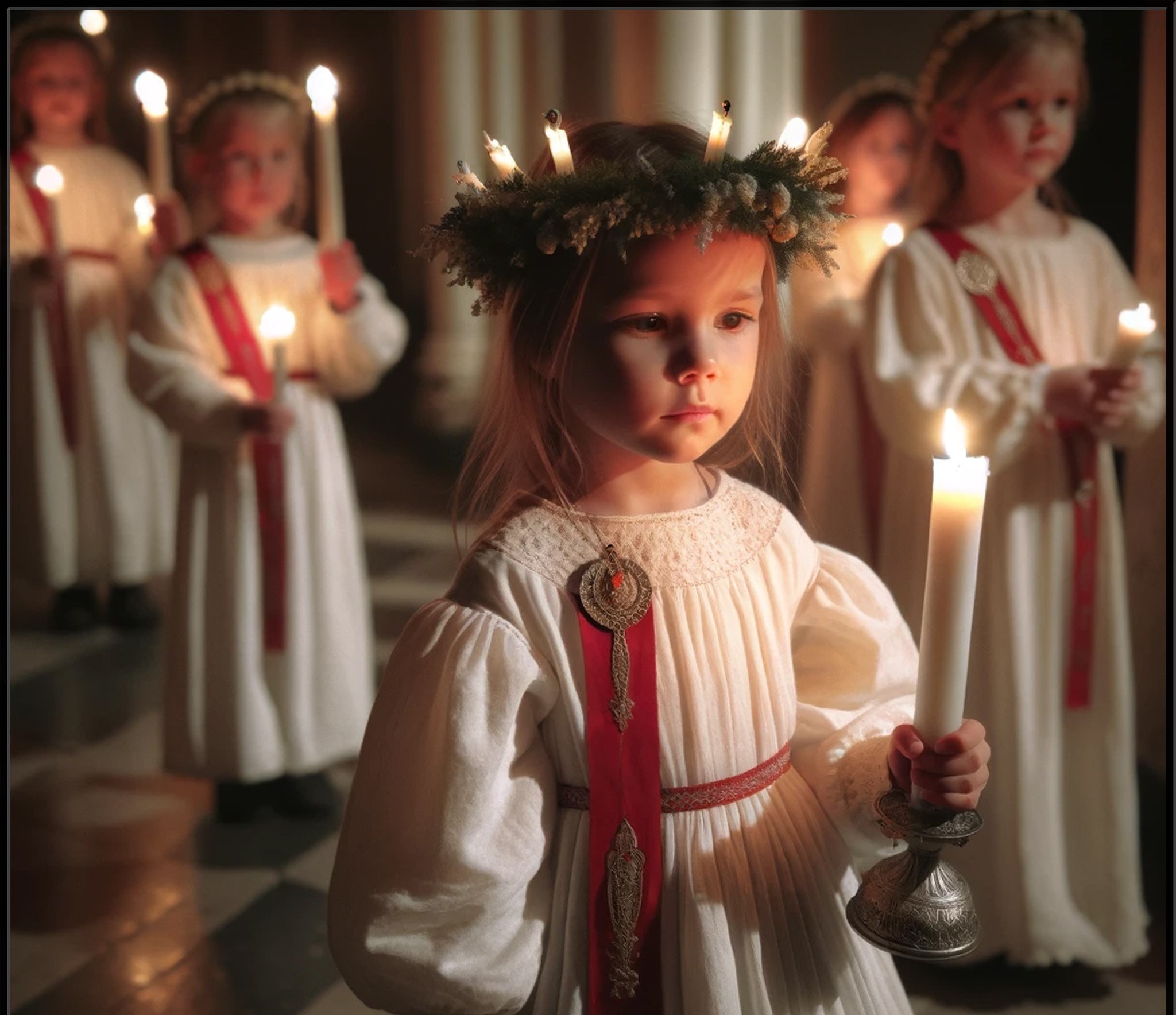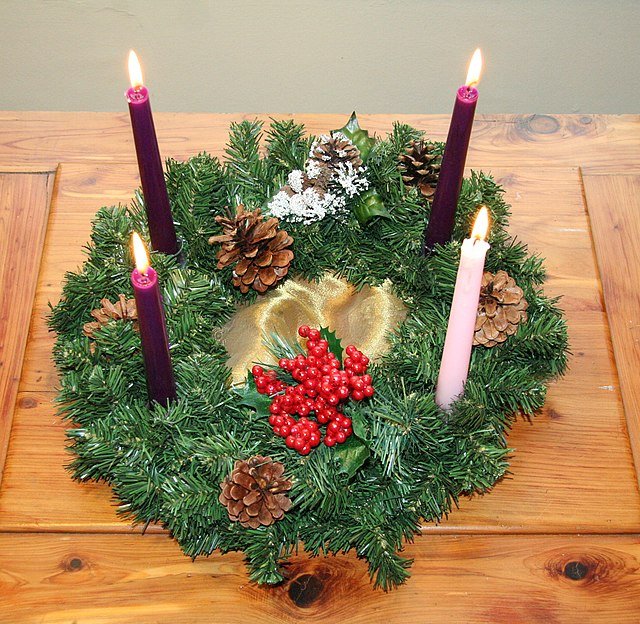Today, December 13th, heralds the Swedish “Festival of Lights” -- St. Lucia’s/Lussi’s Day. Before I moved to Minnesota, I had never heard of the celebration of Saint Lucia Day, but here in the land heavily populated by Swedish, Finnish, and Norwegian immigrants, it is widely celebrated. Saint Lucia, whose name means “light,” was born into a wealthy, noble family in Sicily, and raised by her mother as a Christian. In hopes of curing her mother of illness, she pledged her virginity to God and planned to distribute her dowry to the poor. According to the legend, her spurned betrothed reported her to be a witch to the Roman authorities who sentenced her to a life of prostitution. However, when the time came to take her to the brothel, she was immovable. Neither was she able to be consumed by fire. Finally, she was executed by sword in 304, and later was venerated as a saint by the Catholic Church.
According to Swedish legend, after her death a ship carrying a young woman believed to be Lucia, "clothed in white and crowned with light," appeared on Swedish shores during a great famine. There she distributed food and clothing to the needy, carrying candles on her head in order to carry more food, endearing her to the Swedish people. At some point, probably during the time of the witch-burnings, another less-known legend of Lucia circulated that she was Adam’s first wife, who, just as St. Lucia refused her betrothed, left Adam. Like Lucia, she was accused of being a witch who rode at night with her accompanying spirits, the Lussiferda. Her name was also seen as connecting her to Lucifer, which is in line with the beliefs at the time that witches consorted with the devil. In addition, she was considered to be the goddess who helped birth babies, bringing them from the dark into the light – another connection with the demonization of midwives at that time. During this period, on Lussinatta – or Lucy’s Night – families huddled inside, keeping watch all night to protect themselves and their children from Lussi’s evil powers. But this part of the legend has long since been forgotten, and Lussi continues to be celebrated on her feast day of December 13th. Once thought to be the longest night of the year, her celebration ushers in the coming of the light and the Christmas season. Girls dressed in white with red sashes, wearing wreaths of lighted candles on their heads, process into the hall, sanctuary, or family living room, carrying coffee and lussekatt (saffron buns) to be given in honor of she who gave food to the poor.
This year it seems we need the light more than ever. The approaching winter has felt darker than usual. Here in the north, where usually we are blanketed with snow this time of year, this year we have none. All around town people are putting up holiday lights, but without the snow to reflect the light, the beams and sparkles of light do not carry. Without the softening effect of billows of snow, they can even seem a bit garish.
But it is not just the lack of snow that renders these days darker. With the wars raging in the Ukraine, Gaza, Yemen, Sudan and smaller conflicts around the world; a politics of division, ignorance, and hate rising alarmingly throughout this country; the ongoing climate crisis -- these can seem dark days indeed, rendering our attempts at holiday cheer a bit garish as well.
And yet, we go in search of light, both physical and metaphysical. Here in Duluth cars line up for more than a mile to get to “Bentleyville,” a walking tour of more than five million lights in the shapes of Christmas trees, poinsettias, snowmen, Santas, reindeer, snowflakes, and archways covered in lights. It’s become one of the city’s main tourist attractions, drawing people from hundreds of miles away.[i]
This year, the heavens are providing their own light display. With the current solar storms, we’ve been blessed with night after night of “northern lights” – the Aurora Borealis. While they’ve eluded my search so far this year, my Facebook page lights up nearly every morning with photos from friends who have seen them. People will stay up far into the night to catch these magical curtains of light in their pink and green array – a truly magical sight.
Religious celebrations around the world centered in the lighting of lamps and candles abound this time of year. The Hindu festival of lights, Diwali, celebrates the victory of light over darkness with the lighting of row upon row of lamps. Each night of the Jewish holiday of Hannukah, an additional candle in the menorah is lit, commemorating the miracle of one jar of oil lasting long enough – eight nights – to rededicate the temple after the Maccabees won it back from the Greek invaders. Each day of Kwanzaa, families light one of the seven candles in the kinarah, each candle dedicated to one of the seven principles of Kwanzaa – unity, self-determination, responsibility, cooperative economics, purpose, creativity, and faith. During each of the four weeks of Advent, Christians celebrate the coming of the birth of Jesus by lighting one of the four candles in the Advent wreath – the light of hope, of love, of joy, and of peace. Solstice traditions vary considerably, but in our community celebration of the winter Solstice, each took turns lighting one of the thirteen Solstice candles, dedicating it to their hopes for the new year, and then jumping the Solstice fire, leaving the woes of the past behind and with good wishes for the year ahead.
The flames symbolize the light we are truly seeking – the light of hope for a darkened world. In pre-pandemic days, every Wednesday evening of Advent, I played music for “Prayers Around the Cradle.” It was a meaningful time of contemplation in the darkened sanctuary, with the reading of short inspirational verses, the singing of Taizé chants, and the lighting of candles – each with a blessing or prayer. By the end, the sand tray table would be ablaze with light, carrying our hopes for the world and loved ones near and far. Some of us would stay long, listening to each other, providing comfort, or simply taking in the light. No matter what cares or concerns I may have been holding, I always felt lightened by the time together.
As feminist Jewish scholar Ivy Helman wrote of the celebration of Hanukkah: “We don’t need the temple to bring more of the divine essence into the world. Rather we need each other. . . . For us now, the Holy One indwells more in this world the more we bring: hope into a hopeless situation; friendship into a lonely situation; love into a loveless situation; care into a difficult situation. . . “[ii]
I saw this the other day as our local chapter of Grandmothers for Peace distributed food and warm clothing to anyone in need. On Friday noons, they join with Women in Black[iii], standing in silent vigil calling for a ceasefire in the Middle East. I see in these actions both faces of Lucia/Lussi – women claiming power, standing up to the authorities, immovable, and also spreading the light that we are most seeking at this time – the light of care, of peace, of love.
My favorite part of the Christmas Eve service is the traditional candle lighting ceremony, when, while singing “Silent Night,” we pass the flame, one person to the next, until all the sanctuary is filled with light. Certainly this sharing of the light of love is the light we seek. All it takes is for us to find that light within ourselves and pass it on to someone else. In the words of the children’s hymn, “If I light just one candle, and you light just one, too, and we pass the flame from wick to wick, from us to you and you. And if we keep it going around the world, you’ll see the world is glowing with the light that came from you and me! With one candle, just one candle. Yes, one candle burning bright. With one candle, just one candle, we can fill the world with light.”
References
Helman, Ivy. From the Archives: “I Missed a Day Again: Reflections on Hanukkah.” (feminismandreligion.com)
Jennings, Teresa. “Just One Candle.”
Saint Lucy | History, Patron Saint, Eyes, & Feast Day | Britannica
The Festival of Saint Lucia - Swedish Legend | St. Lucia (gustavus.edu)
[i] For more information on and photos of Bentleyville, see Bentleyville "Tour of Lights" (bentleyvilleusa.org)
[ii] In a post written for the “Feminism and Religion” blog, Helman wrote of her struggle with the celebration of militarism in the original Hanukkah commemoration of the military victory of the Maccabees over the Greeks. Ultimately, however, she realized this was only a part of the celebration and that the true meaning of Hanukkah is in bringing the indwelling of God back into the temple and the world.
[iii] Women in Black was formed by Israeli women in 1988 after the First Intifada, in concern over what they considered to be serious violations of human rights by Israeli soldiers in the Occupied Territories of the West Bank and Gaza. Clothed in black, they stood in silent vigil every Friday in central Jerusalem. Since that time, the movement has grown to nearly 10,000 anti-war activists around the world.






